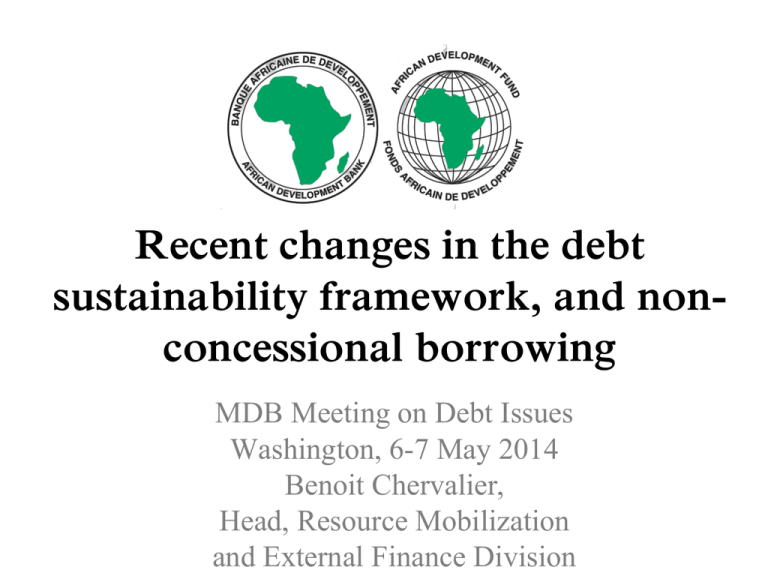Recent changes in the debt sustainability framework
advertisement

Recent changes in the debt sustainability framework, and nonconcessional borrowing MDB Meeting on Debt Issues Washington, 6-7 May 2014 Benoit Chervalier, Head, Resource Mobilization and External Finance Division Outline of the Discussion I. Diagnostics II. Responses III. Concluding remarks Background May 2000 November 2011 Diagnostics: A Rising Africa… Between 2000 and 2010: 6 of the world’s 10 fastest growing economies were ADF Countries Average growth of more than 5% World’s 10 fastest growing economies b (annual average GDP growth, %) 2001–2010 c 2011–2015 d Angola 11.1 China 9.5 China 10.5 India 8.2 Myanmar 10.3 Ethiopia 8.1 Nigeria 8.9 Mozambique 7.7 Ethiopia 8.4 Tanzania 7.2 Kazakhstan 8.2 Vietnam 7.2 Chad 7.9 Congo 7.0 Mozambique 7.9 Ghana 7.0 Cambodia 7.7 Zambia 6.9 Rwanda 7.6 Nigeria 6.8 a. The Economist, January 6, 2011. b. Excluding countries with fewer than 10 million people. c. 2010 estimate. d. Forecast. 4 Classification of RMCs by HIPC Status (as at End-March 2014) Countries Status and Debt Relief Provided USD mm 8,533 8,533 6,085 4,938 HIPC Debt relief committed MDRI Debt relief delivered Debt relief under HIPC and MDRI has substantially alleviated debt burdens in recipient countries and has enabled them to increase their povertyreducing expenditure by almost three and a half percentage points of GDP between 2001 and 2012 Diagnostics • Increased trend on accessing international capital markets • Context of low interest rates Country Issue date Maturity (years) Amount (USD mm) Yield Subscr. (times) Zambia Aug-12 7 750 5,625 % 16 Rwanda May-13 10 450 6.875 % 9 Nigeria Jul-13 10 500 6.625 % 4,5 Ghana Aug-13 10 1000 7.875 % 2,7 Country 10 year maturity Yield (end 2012) 10 year maturity Yield (end 2013) United States 1.912 % 3.028 % Germany 1.479 % 1.929 % Italy 4.232 % 4.125 % Portugal 6.329% 6.010% Spain 5% 4.128% Diagnostics • Post-HIPC and MDRI countries are still constraint by Debt Sustainability Framework • Need for resources but concessional aid (for Africa) is declining Net ODA 160 140 120 100 80 60 40 20 0 1997 1998 1999 2000 2001 2002 2003 2004 2005 2006 2007 2008 2009 2010 2011 2012 Net ODA Diagnostics • Relative low risk of debt distress • However some degree of vulnerability to exogenous shocks Effect of Hypothetical $500mn Eurobond Issuance Country % GDP % Gov. Revenue Increase in debt level (% leave) South Africa 0.1 0.5 0.3 Nigeria 0.2 0.6 1 Kenya 1.1 4.2 2.2 Ghana 1.2 5.5 2.1 Cameroon 1.8 9.6 10 Responses • Amend the Debt Sustainability Framework • Measures to accompany countries in accessing to capital markets • Graduation frameworks for smooth transition • Innovative Financial instruments RESPONSES: Debt Sustainability Framework • More flexibility (debt limits) • Smart Investments Responses: Access to Financial Markets • Implement measures to reduce effective borrowing costs – Guarantees to extend debt maturities or Improve access to capital markets (e.g. ADF’s new Partial Credit Guarantee) • Need to finance sustainable projects (financing infrastructure gap) • Advisory services Responses: Graduation • Graduation policy – Creditworthiness assessment exercise – Differentiation among ADF countries under ADF 13 • Adoption in 2011 of the Transition Framework for countries changing status Responses: Innovative Financial Instruments • Amendments of the Credit Policy (currently under revision) • Donor loans (IDA-17, WG ADF-13) • Guarantees African countries Issuing Bonds (2011-2013) Morocco Egypt ADF Countries ADB Countries Senegal Nigeria Ivory Coast Africa bond issuance Ghana Gabon Rwanda Tanzania Angola Zambia Mozambique Namibia 2008 2009 2010 2011 2012 2013 Lehman collapse 200 mn USD 4.8 bn USD 1.5 bn USD 4.3 bn USD 9.6 bn USD African Countries accessing financial markets (excluding South Africa) • Exponential growth in the last 3 years Total amount Issed (ADB+ADF) Variation 9050 4265 1500 2011 +4785 +2765 2012 2013 With an average spread of 563 basis points ADB Countries accessing financial markets (excluding South Africa) ADB Amounts Increase 5200 3328 500 2011 +1872 +2828 2012 2013 With an average spread of 503 basis points ADF Countries accessing financial markets ADF Amounts Variation 3850 +2913 1000 2011 937 -63 2012 2013 With an average spread of 650 basis points Concluding Remarks • A crossroad: Opportunities and Risks – Risks: growing domestic debt in many LICs; countries going to borrow from the capital market (rationale, where to invest, structural deficits) – Opportunity for reforms: innovative approaches; accelerated graduation for some countries • Adequate responses needed to ensure long term financial sustainability







